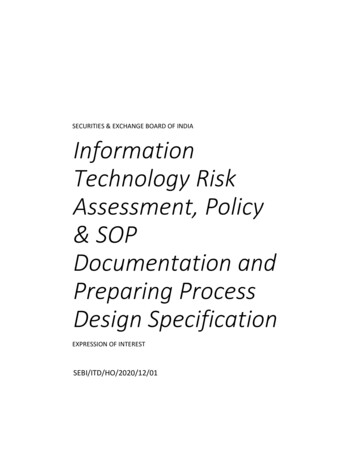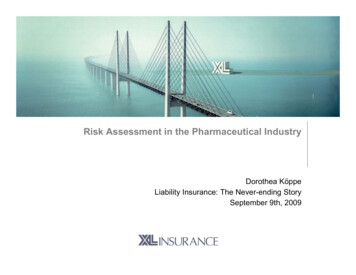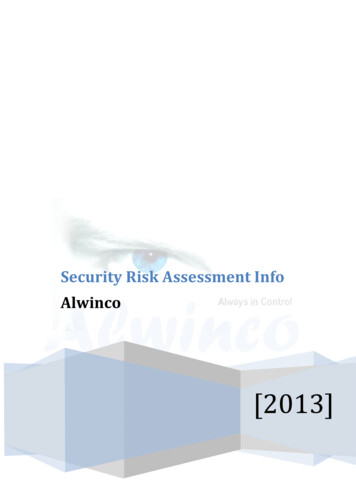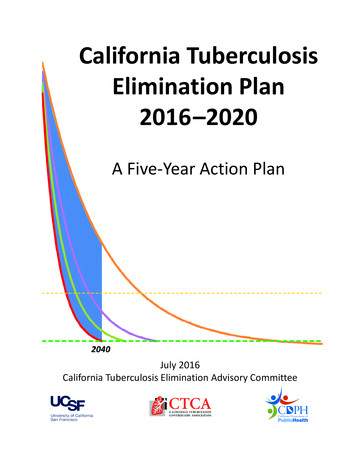
Transcription
SECURITIES & EXCHANGE BOARD OF INDIAInformationTechnology RiskAssessment, Policy& SOPDocumentation andPreparing ProcessDesign SpecificationEXPRESSION OF INTERESTSEBI/ITD/HO/2020/12/01
ContentsSECTION I – INTRODUCTION . 2SECTION II – SCHEDULE OF EVENTS . 3SECTION III – BACKGROUND . 4SECTION IV – SCOPE OF WORK . 6SECTION V – BIDDER’S ELIGIBILITY CRITERIA . 43SECTION VI – EOI SUBMISSION PROCESS . 45SECTION VII – EVALUATION OF EOI . 47SECTION VIII – TERMS & CONDITIONS. 58ANNEXURE I - ELIGIBILITY CRITERIA. 62ANNEXURE II - EOI SUBMISSION FORM. 64ANNEXURE III – BIDDER’S INFORMATION DETAILS. 65ANNEXURE IV- PROJECT DETAILS. 68ANNEXURE V- ESTIMATED COST . 69ANNEXURE VI- CHECKLIST . 70ANNEXURE VII- Details of SEBI Custom Applications for Budget Estimate . 71Page 1 of 73
SECTION I – INTRODUCTION1. Securities and Exchange Board of India (SEBI) is a statutory body, which operateswithin the legal framework of Securities and Exchange Board of India Act 1992. Itsstatutory objectives are:a. Protection of interests of investors in securitiesb. Promotion and development of the securities marketc. Regulation and supervision of securities market and matters incidentalthereto2. SEBI invites Expression of Interest (EOI) from established, reputed and reliableSolution Providers (Bidders) for “Information Technology Risk Assessment, Policy& SOP Documentation and Preparing Process Design Specification” and havenecessary capability, suitable capacity and relevant experience to provide theseservices.Page 2 of 73
SECTION II – SCHEDULE OF EVENTSSN1.2.3.4.EventDate of commencement of EOI ProcessLast date and time for receipt of queries (through emailsonly) for clarification from applicantsLast Date and Time for EOI Submission along with allsupporting documents.Opening of EOIsPage 3 of 73DateDecember 15, 2020December 24, 202005:00 PMJanuary 08, 202103:00 PMJanuary 08, 202104:00 PM
SECTION III – BACKGROUND1. IT risk assessment helps to determine the vulnerabilities in information systemsand the broader IT environment, assess the likelihood that a risky event will occur,and rank risks based on the risk estimate combined with the level of impact that itwould cause if it occurs. It will also help in identifying controls and measuresrequired to be included in IT policies and Standard Operating Procedures (SOP).2. The concept of risk is a key consideration in policy making. A wellwritten Organization level IT policy, procedure and manual reduces operatingcosts and improves performance by enhancing consistency and establishing clearcriteria for computer, network, hardware, software, information security, and ITvendor management. Establishing consistent IT SOP best practices andoperational methods are an important component in safeguarding informationsystems, IT assets, and IT investments.3. SEBI intends to conduct risk assessment, prepare policy documents, standardoperating procedures (SOPs), documentation of procedures and processes andother IT documents through consultation. SEBI also requires design specificationdocument to be prepared for all the selected processes for automation.4. SEBI has certain policy documents in place which might require variations as perthe best industry standards and practices.5. SEBI expects to prepare and implement a suitable governance structure i.e.comprehensive policy and procedure documents that are custom-made to suit tothe needs of the business and advising staff of their obligations to ensure ongoingcompliance.Page 4 of 73
6. Expression of Interest (EOI) is invited in sealed envelope superscripted as “EOI “Information Technology Risk Assessment, Policy & SOP Documentation andPreparing Process Design Specification”:1. from the Bidders who meet the eligibility criteria as set out in “SECTION V”2. agree to abide by all the other terms and conditions in this EOI documentBy participating in this bidding process Bidder confirms that bidder is in agreementwith all the Terms and Conditions of this EOI.Page 5 of 73
SECTION IV – SCOPE OF WORKThe overall scope of work of the Bidder(s) would be as follows:Following is the indicative list of activities envisaged to meet the scope of work.However, the detailed scope of work / list of activities would be finalized at the timeof issue of RFP.Risk Assessment1. Bidder is required to perform in-depth Risk Assessment for IT infrastructuredeployment at SEBI. The risk assessment needs to include identification offoreseeable threats, assessment of the likelihood and potential damage of thesethreats, and the sufficiency of controls to mitigate risks.The process should include but not limited to the following:1.1 Data classification categories1.2 Inventory systems1.3 Initial risk of each system1.4 Group Technologies1.5 Vulnerabilities and threats for each system1.6 Threat Assessment1.7 Controls for each vulnerability or threat1.8 Classification of controls1.9 Acceptable approach for Controls1.10 Residual Risk1.11 Reports2. Bidder is supposed to conduct risk assessment of IT infrastructure deployment atSEBI annually, calculate risk score accordingly, review controls and its impact onPolicies and SOPs and changes required in the reviewed policies and SOPs.Details regarding frequency and activity are mentioned in Section VIII Point 17.3. Bidder is required to define risk assessment methodology for SEBI in order todefine the rules by which risk assessment will be performed. The methodologyneeds to address following four issues:a. Baseline security criteria;b. Risk scale; categorizes risks along a multidimensional ranking, based on acomparative evaluation of the consequences, probability, and source of agiven riskPage 6 of 73
c. Risk appetite; level of risk that SEBI is prepared to accept in pursuit of itsobjectivesd. Scenario-based or asset-based risk assessment.Project wise as well as organizational level risk assessment methodology definedfor SEBI shall be documented and shared with SEBI for approval. Themethodology shall include following:3.1Identify and prioritize assetsSEBI maintains inventory list of all IT assets. Bidder is required to identifyinformation assets of SEBI from the inventory list and other details available withSEBI. Bidder has to work with individual IT project owners, IT support vendors,IT officials and business users to create a list of all valuable assets. Theinformation assets shall include hard copies of information, electronic files,removable media, mobile devices and intangibles, such as intellectual propertyetc. For each asset, bidder has to gather the following information, or any otherinformation as applicable: SoftwareHardwareDataInterfacesUsersSupport personnelPurposeCriticalityFunctional requirementsIT Security policiesIT Security architectureNetwork topologyInformation storage protectionInformation flowTechnical security controlsPhysical security environmentEnvironmental securityBidder is required to identify mission-critical assets. Bidder needs to define astandard for determining the importance of each asset. Common criteria mayinclude the asset’s monetary value, confidentiality, legal standing and importanceto SEBI but bidder is required to identify more such criteria. Once the standardPage 7 of 73
has been approved by SEBI and formally incorporated into the risk assessmentsecurity policy or appropriate document, bidder has to use it to classify each assetidentified as critical, major or minor.3.2System CharacterizationBidder has to Identify and characterize threat sources of concern, includingcapability, intent, and targeting characteristics for adversarial threats and rangeof effects for non-adversarial threats.With respect to critical data, either in hard copy or in soft copy, bidder has todetermine data classification categories. These categories shall be based on non-public personal information; data that should be restricted to a limited number of employees; data that should be restricted from non-employees; data relied upon for risk management or decision-making purposes; and data that is critical to the internal operations. data that has commercial valueThe way data is categorized, same way inventoried systems are required to beclassified. After classification of inventoried systems, initial risk has to bedetermined. Initial risk shall be highest initial risk, medium initial risk and lowinitial risk.Out of these inventoried systems, bidder has to identify technology groups suchas Windows Servers, Linux servers, network switches of same make and model,databases etc. Once technology groups are identified, it is required to map themwith risk classification along with vulnerabilities identified with the technologygroup.3.3Threat IdentificationA threat is anything that could exploit a vulnerability to breach security and causeharm to the organization. Bidder is required to identify all such potential threatevents, relevance of the events, and the threat sources that could initiate theevents. While identifying the malicious behavior, bidder shall consider following: Channels; that a computer resources in SEBI can be accessedinternally or externally. Interference; when somebody causes damage by deleting data, engineeringa distributed denial of service (DDOS) against website, physically stealing acomputer or server, and so on.Page 8 of 73
Interception; classic hacking. Impersonation; misuse of someone else’s credentials, which are oftenacquired through social engineering attacks or brute-force attacks, orpurchased on the dark web.Bidder has to work with individual IT project owners, IT support vendors, ITofficials and business users to identify threats.3.4Vulnerability IdentificationBidder is required to identify vulnerabilities both internal and external to SEBI andpredisposing conditions that affect the likelihood that threat events of concernresult in adverse impacts. For each identified technology group, bidder is requiredto assign vulnerability and threats associated with it. Vulnerabilities can beidentified through vulnerability analysis, audit reports, VAPT reports, the NISTvulnerability database, vendor data, CERT-In security alert, and system softwaresecurity analysis. Testing the IT system is also an important tool in identifyingvulnerabilities. Testing shall include the following: Information Security Test and Evaluation (ST&E) proceduresPenetration testing techniquesAutomated vulnerability Scanning toolsThe sources consulted shall include: SANS Top 20 (www.sans.org/top20/)OWASP Top 10 (www.owasp.org/documentation/topten.html )NIST I-CAT vulnerability database (icat.nist.gov)Microsoft Security Advisories (www.microsoft.com/security ) CA Alert service (www3.ca.com/securityadvisor)3.5 Control AnalysisThis phase includes assessment of controls already been implemented orplanned, probability that they can be broken, assessment of potential loss despitethe existence of such controls. Bidder is required to analyze the controls that areeither in place or in the planning stage to minimize or eliminate the probability thata threat will exploit vulnerability in the system. Controls may be classified asbelow: Non-technical controls also called management controls; includessecurity policies, administrative actions, and physical and environmentalmechanisms.Page 9 of 73
Technical controls; computer hardware or software, encryption, intrusiondetection mechanisms, and identification and authentication subsystems.Both technical and non-technical controls can further be classified as preventiveor detective controls. As the name implies, preventive controls attempt toanticipate and stop attacks. Examples of preventive technical controls areencryption and authentication devices. Detective controls are used to discoverattacks or events through such means as audit trails and intrusion detectionsystems.Bidder is supposed to identify desired amount and mix of controls to have anacceptable approach to address threats in different tiers (higher risk systems,medium risk systems and low risk systems). Bidder has to identify acceptablecontrols approach.The output of this step is current or planned controls used for the IT system tomeasure the likelihood of vulnerability being exercised and reduce the impactof loss. The output is required to be shared with SEBI.3.6Identify Threat-source / Vulnerability PairsBidder is required to identify all existing threat- source and associatedvulnerability pairs. Bidder is supposed to develop threat scenarios which isanalytically useful, since some vulnerabilities may not be exposed to exploitationunless and until other vulnerabilities have been exploited. Bidder is required toidentify how a set of vulnerabilities, taken together, could be exploited by one ormore threat events. Such analysis is therefore more useful than the analysis ofindividual vulnerabilities.3.7Determine the Likelihood of an incidentBidder is supposed to determine the likelihood that threat events of concern resultin adverse impacts, considering:a. the characteristics of the threat sources that could initiate the events;b. the vulnerabilities/predisposing conditions identified; andc. the organizational susceptibility reflecting the safeguards/countermeasuresplanned or implemented to impede such events.Bidder is required to use following categories to assess the likelihood of an attackor other adverse event:Likelihood level (Weight Factor)High (1.0)Likelihood definitionThe threat source is highlymotivated and sufficiently capablePage 10 of 73
and controls to prevent thevulnerability from being exercisedare ineffectiveMedium (0.5)The threat source is motivated andcapable but controls are in placethat may impede the successfulexercise of the vulnerability.Low (0.1)The threat source lacks motivationor capability or controls are inplace to prevent or at leastsignificantly impede thevulnerability from being exercised.3.8 Impact AnalysisBidder has to determine the adverse impacts from threat events of concernconsidering:a. the characteristics of the threat sources that could initiate the events;b. the vulnerabilities/predisposing conditions identified; andc. the susceptibility reflecting the safeguards/countermeasures planned orimplemented to impede such events.Impact analysis should include the following factors: The mission of the system, including the processes implemented by thesystem The criticality of the system, determined by its value and the value of thedata to the organization The sensitivity of the system and its dataThe information required to conduct an impact analysis can be obtained fromexisting organizational documentation or from the newly framed documents aspart of the overall scope of this EOI, including a business impact analysis (BIA).This document uses either quantitative or qualitative means to determine theimpact that would be caused by compromise or harm to SEBI’s informationassets.Page 11 of 73
An attack or adverse event can result in compromise or loss of information systemconfidentiality, integrity and availability. As with the likelihood determination, theimpact on the system can be qualitatively assessed as high, medium or low.The following additional items should be included in the impact analysis: The estimated frequency of the threat’s exploitation of a vulnerability on anannual basis The approximate cost of each of these occurrences A weight factor based on the relative impact of a specific threat exploiting aspecific vulnerability3.9 Risk DeterminationBidder is required to determine the risk to the organization from threat events ofconcern considering:a. the impact that would result from the events; andb. the likelihood of the events occurring.Risk Threat Likelihood Magnitude of ImpactFor each threat/vulnerability pair, bidder has to determine the level of risk to theIT system, based on the following:a. The likelihood that the threat will exploit the vulnerabilityb. The impact of the threat successfully exploiting the vulnerabilityc. The adequacy of the existing or planned information system securitycontrols for eliminating or reducing the riskLikely(0.8)Moderate(0.5)Threat LikelihoodVeryLikely(1.0)Bidder is required to prepare risk-level matrix which shall include following:Page 12 of 73
derate (50)Major(80)Extreme(100)A high likelihood that the threat will occur shall be given a value of 1.0; a mediumlikelihood shall be assigned a value of 0.5; and a low likelihood of occurrenceshall be given a rating of 0.1. Similarly, a high impact level shall be assigned avalue of 100, a medium impact level 50, and a low impact level 10. Risk iscalculated by multiplying the threat likelihood value by the impact value, and therisks are categorized as high, medium or low based on the result.Bidder is required to calculate Risk Score for each likelihood of threat and impactof the threat.3.10 Control RecommendationsBidder is required to recommend controls that could mitigate or eliminate theidentified risks appropriate to SEBI's operations. The control recommendationsare the results of the risk assessment process.Using the risk level as a basis, bidder has to determine the actions that seniormanagement and other responsible individuals must take to mitigate the risk.Bidder may recommend some general guidelines for each level of risk, which maybe as follows: High— A plan for corrective measures should be developed as soon aspossible.Medium — A plan for corrective measures should be developed within areasonable period of time.Low — The team must decide whether to accept the risk or implementcorrective actions.While recommending controls to mitigate each risk, bidder is required to consider: Organizational policiesCost-benefit analysisPage 13 of 73
Operational impactFeasibilityApplicable regulationsThe overall effectiveness of the recommended controlsSafety and reliability3.11 Results DocumentationThe final step in the risk assessment process is to develop a risk assessmentreport to support management in making appropriate decisions on budget,policies, procedures and so on. Bidder is expected to prepare risk assessmentreport and present it to SEBI.For each threat, the report should describe the corresponding vulnerabilities, theassets at risk, the impact to the IT infrastructure, the likelihood of occurrence andthe control recommendations.The results may be summarized as per following ingControlsLikelihoodImpactRiskRatingRecommended ControlsThe risk assessment report shall be comprised of all sub-sections from 3.1 to3.11.Bidder is expected to prepare Risk Assessment Policy that defines what SEBImust do periodically (preferably annually), how risk is to be addressed andmitigated, and how SEBI must carry out subsequent enterprise risk assessmentsfor its IT infrastructure components and other assets. Bidder is required tosuggest effective control measures to bring down high risk area to within tolerableresidual risk value.4. After completion of risk assessment, bidder is expected to review all the existingpolicies and SOPs.Policy DocumentationPage 14 of 73
5. Bidder is supposed to prepare5.15.2General IT policies applicable to all computer resources, users across SEBIand projects (scope of work is explained in detail below), andfor each SEBI project, an umbrella Project Policy Document (IntegratedProject Manual) which identifies all applicable SEBI-wide IT policies, withspecific instantiations, customizations, enhancement and exemptionsneeded for the underlying processes, principles and controls.6. Bidder is required to gather details for documentation of Project Policy Document(Integrated Project Manual) and its processes through meetings and interactionswith individual IT project owners, IT support vendors, IT officials and businessusers of SEBI.7. Bidder is supposed to review all IT systems implemented in SEBI and prepare acomprehensive list of all the policies required by and/or recommended for SEBI.Selected bidder is expected to prepare and/or review both general IT policies andproject specific IT policies which explain various underlying processes, principlesand controls. These processes, principles and controls together shall constitute asecure, safe and objective operational area for the IT operations and shall driveand converge into standard operational procedures for the area. Main focus ofthese policies are as follows.7.1 Coverage: Each policy shall cover SEBI’s all computer resources and usersincluding employees (permanent or contract), vendors, outsourced staff, otherthird parties and individuals wherever applicable.7.2 Project wise or operational unit wise plan: Each policy shall have organizationallevel operational unit or project wise plan which will be reviewed periodically.This shall ensure maximum coverage of operating procedures followed or tobe followed in each project.7.3 Responsibility matrix: One of the important aspects of effective operation of ITis identification of clear and non-ambiguous responsibility matrix of IToperations. Project wise plan of each policy should contain responsibility matrixfor performing each IT operation in that project.7.4 Plan wise procedures: Each IT operation and procedures in each plan need tobe identified and documented. Bidder should identify feasibility of automatingeach procedure and suggest usage of software scripts or tool for automationwherever practical.7.5 Delegation of power: Accountability is another important aspect of efficient IToperation. To execute each identified operation by the responsibleprofessionals, appropriate authorization is envisaged through delegation ofPage 15 of 73
power. Project wise plan of each policy should contain delegation of power forauthorizing and approving each IT operation in that project.7.6 Standardized forms: Many of the operational areas share common proceduresfor request, approval, communication etc. Each policy should incorporatestandardized forms, procedures, etc. wherever practicable.7.7 Periodic review: Each policy should identify and provide areas of operations,events, statistics, etc. for periodic review for enhancing the efficiency ofoperations.8. The approach for policy development will be bottom-up policy developmentmethod. This will ensure to address the concerns of operational employeesbecause it starts with their input and concerns, and builds on known risk.8.1 Identification of project activities: Each policy document should include projectspecific activities and exceptions, handled by the project owners. Bidder isrequired to work with individual IT project owners, IT support vendors, ITofficials and selective business users to identify and create list of clearactivities, tasks, milestones or deliverables for each project.8.2 Mapping of project wise activities: Bidder is supposed to map each activityidentified within a project to appropriate policy. If any of the identified activitydoes not correspond to any general IT policy, then a project specific policy orprocedure needs to be created and mapped appropriately.8.3 Mapping of responsibility: Bidder is required to map each identified activity,task, milestone or deliverable within a project to a role to design responsibilitymatrix and accountability. This step should result into a matrix like below:Project Name 1Table 1: RACI MatrixRole 1Task 1Task 2Role 2RRRole 3Role 4Role 5ACIRole 6AITask 3ARTask 4ATask 5AIRTask 6AIRPage 16 of 73IR
9. Bidder may use a Responsibility Assignment (RACI) matrix or any other matrix asper best suitability or best industry practices. Bidder shall identify and assignResponsible, Accountable, Consulted and Informed roles for each task. Every taskor deliverable should have a Responsible and Accountable at least. Only onename or role should be assigned to Accountable.The organization structure in SEBI is as stated below:Head of the Department (CGM)Division Chief (DGM/GM)Officers (AM/MGR/AGM)Table 2: Project wise Activity Mapping Chart AProjectTeamActivityTypeMappingTask 1OfficerTask 3Task 4Policy AResponsiblePolicy DTask 5DivisionChiefHead of theDepartmentTask 1Task 2Task 5Policy CAccountableConsultedPolicy APolicy BPolicy EPolicy FSelected bidder is expected to prepare and/or review below mentioned indicative (notexhaustive) list of policies.A Information Technology Policies1 IT Assets Administration and Management Policy2 Access Control / Management & Review Policy3 Capacity PlanningIT Human ResourcePage 17 of 73ManagementTrainingSkill set development
IT Infrastructure (Servers, Desktops, Data Centers,Network Devices, Storage, Bandwidth and otherequipment)Development Lifecycle PolicySecure SDLCQuality 72829ApplicationDevelopmentUser Acceptance TestNon-functional tests (stress test, application security,destructive test etc.)Version ManagementSystem AuditIn-house developmentThird party developmentData Sharing PolicyBring Your Own Device (BYOD) policyNetwork Access PolicyDesktop Data Backup PolicySoftware Upgrade PolicyInternet and Email Usage PolicyAccount and User Rights Management PolicyChange Management PolicyPatch Management PolicyPassword Management PolicyInternet Security PolicyData Backup, Recovery & Restoration PolicyDisaster Recovery and BCP PolicyLogging and Monitoring PolicyBusiness Requirement Collection and Documenting PolicyComputer Resource Installation and Application Implementation Sign OffPolicyInformation Technology Incident Management PolicyConfiguration Management PolicyMobile Computing PolicyVirtualization Management PolicyData Migration PolicyLog and Record Retention PolicySystem Acquisition, Configuration and Maintenance PolicyNetwork Operation Center PolicyPrivate Cloud Management PolicyPage 18 of 73
30 IT Compliance & Review Policy31 Third-Party System Installation Policy32 Downtime Management PolicyB IT Governance and Management PoliciesIT GovernanceITService Enterprise Architecture1ManagementProject ManagementIT BudgetPurchase PolicyEquipment Allocation, De-allocation & Relocation2 ProcurementEquipment Usage, Maintenance and SecurityIT Obsolescence Management3 IT Risk Management and Supervision4 IT Service Request / Service Desk / Help Desk Management /Support Policy5 IT Service Level Agreement Policy6 IT Vendor Management PolicyC1234567891011121314151617181920Cyber Security PoliciesCyber Security PolicyInternet Connection, Firewall, IDS & IPS Security PolicyIS Compliance PolicyAntivirus Management PolicyEmail Communication PolicyPrivacy PolicyThird-Party Security PolicySocial Media Usage PolicyCommunications Security PolicyInternet and Intranet PolicyPrivileged Account Management PolicyOutsourcing PolicyInformation Security aspects of Business Continuity ManagementInformation Security Training and Awareness PolicyCyber Security Incident Management PolicyApplication Security PolicyEndpoint Security PolicyOperating System Security PolicyDatabase Security and Access PolicyWeb Server Security PolicyPage 19 of 73
4647484950515253545556575859Mobile Application Security PolicyCloud Computing and Security PolicySecurity Operation Center PolicyAcceptable Use of Assets and Controls PolicyRemote Access PolicyWebsite Content Update PolicyData Governance and Classification PolicyData Leakage Prevention PolicyData Retention PolicyRisk Assessment and Risk treatment PolicyStatement of applicability (SoA)Cryptography PolicyPhysical & Environmental Security PolicySegregation of Duties PolicyWireless PolicyVPN Security PolicyTelecom Security & Related Equipment Controls PolicyDigital Signatures PolicyMedia Controls PolicyIntellectual Property Rights Security PolicyLegal Requirements & Compliance Controls PolicyData Centre Security PolicyPersonnel Security PolicyServer Security PolicyData Breach Response PolicyEnd User Encryption Key Protection PolicyEthics PolicyPandemic Response Planning PolicySecurity Response Plan PolicyEmail Retention PolicyExtranet PolicyServer Audit PolicyServer Malware Protection PolicySocial Engineering Awareness PolicyClean Desk PolicyRouter and Switch Security PolicyDMZ Security PolicyInternet DMZ Equipment PolicyMobile Device Management & Encryption PolicyPage 20 of 73
60 Personal Communication Devices and Voicemail PolicySample template for the policy: A policy is a deliberate system of princi
Technical controls; computer hardware or software, encryption, intrusion detection mechanisms, and identification and authentication subsystems. Both technical and non-technical controls can further be classified as preventive or detective controls. As the name implies, preventive controls attempt to anticipate and stop attacks.











